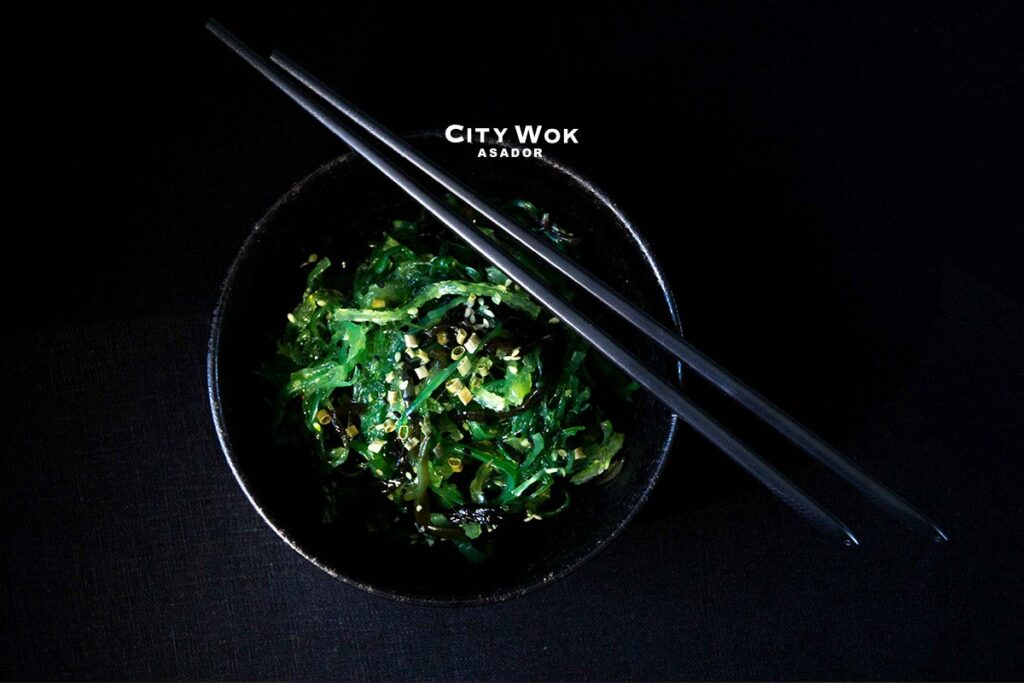Alga wakame y su influencia en todo el mundo

El alga wakame, crece de forma silvestre en las aguas marinas profundas. Es de color pardo oscuro que se vuelve verde espinaca cuando se hidrata o se cuece; tiene una textura suave, carnosa y un sabor que recuerda al de las ostras. Desde hace muchos siglos se consume en Asia, de hecho, está muy presente en la tradición culinaria de China, Japón y Corea.
Este tipo de algas suele tener muchas combinaciones y se puede añadir a muchos platos. Normalmente los platos más comunes cocinados con alga wakame son las ensaladas (ensalada wakame, sunomono). También en poke bowls, sopa miso, guarnición o cualquier plato que se acompañe de vinagre de arroz o salsa de soja.
El alga wakame es uno de los alimentos que mayor cantidad de calcio contiene. Tan solo una cucharada sopera de estas algas cocidas, aporta mayor cantidad que un vaso de leche. Otras de las ventajas importantes que nos ofrece el alga wakame respecto a la leche, son la riqueza de esta alga en magnesio.
Otros nutrientes que encontramos en el alga wakame son proteínas, carbohidratos y en menor cantidad grasas, en su mayoría las saludables omega 3. Entre los micronutrientes destacan el potasio, yodo, hierro, vitamina A y las del grupo B, equilibradoras del sistema nervioso. Respecto a estas últimas, cabe resaltar que las algas wakame son las algas más ricas.
Las propiedades beneficiosas del alga wakame
El alga wakame no solo es popular en las mesas de medio mundo por su sabor y facilidad a la hora de cocinar, ha llegado tan lejos por sus extraordinarias propiedades. Cuidar nuestra salud es esencial y la comida tiene mucho que ver a la hora de mantener el cuerpo en perfectas condiciones. La propiedades que presenta este alimento son muchas y es por eso, por lo que se ha convertido en un alimento indispensable para muchas personas.
- Alto contenido en agua, se le atribuyen propiedades antiinflamatorias y antioxidantes.
- Su contenido en vitaminas, ya que permite la regeneración celular y ayuda al buen funcionamiento del organismo.
- Añadir una pequeña cantidad de alga wakame a los platos, ayuda a prevenir el estreñimiento.
- Contiene varios minerales, entre ellos destacar su contenido en calcio y yodo.
- Ayuda a disminuir el colesterol que no es bueno, por lo tanto ayuda a mejorar la salud cardiovascular.
- Purificador sanguíneo. Este es quizás uno de los usos más antiguos de esta alga, además de alimento, ya que en muchos tratados tradicionales de Medicina Tradicional China aparece como recomendación para limpiar y purificar la sangre.
- Salud del pelo. Dado los antioxidantes y otros nutrientes esenciales, la salud del cabello mejora de manera exponencial con su consumo.
- Mejorar la piel. De la misma manera que ayuda a mejorar la salud de la piel, los antioxidantes presentes en las propiedades del alga wakame ayudan a mejorar los tejidos cutáneos y su salud.
- Regulador del ciclo menstrual. Dada las capacidades de este alga para regular las funciones uterinas, se recomienda su ingesta durante el síndrome premenstrual y la regla, para mejorar las funciones, reducir dolores y estabilizar el estado de ánimo.
¿Cómo se prepara del alga wakame?
Hay muchas maneras de preparar el alga wakame en la cocina, como por ejemplo en ensaladas. Basta con remojar el alga unas horas y listo, ya tenemos nuestra lechuga marina. También podemos añadirla en estofados, a las legumbres, a las tartaletas o quiches, sofritos y hasta a las pizzas.
También se puede comer y preparar platos o recetas de alga wakame deshidratada, aunque no está tan buena como rehidratada. Pero sobre gustos no hay nada escrito.
Sin duda, la conclusión es que un vegetal tan rico como el alga wakame debe empezar a formar parte de tu dieta desde ya, tanto por la cantidad de recetas que se pueden hacer con ella (sopas de miso o ramen, ensaladas, poke bowls, etc…) como por sus maravillosos beneficios para el organismo.